Optimization Model for Biogas Power Plant Feedstock Mixture Considering Feedstock and Transportation Costs Using a Differential Evolution Algorithm
Abstract
1. Introduction
2. Model Description
2.1. Mathematical Modeling
- mtfs—total mass of the feedstock (t),
- mi—mass of the i-th feedstock (t),
- n—number of different feedstocks.
- Vtfs—total volume of the feedstock (m3),
- ρi—density of the i-th feedstock (t/m3).
- Vmethane—total volume of methane (Nm3),
- vi—biogas yield of the i-th feedstock (m3/t of input),
- xi—share of methane in 1 m3 of biogas expressed as a dimensionless relative number corresponding to the given percentage value.
- cmethane—cost of 1 m3 of methane (EUR/m3),
- ci—cost of the i-th feedstock (EUR/t),
- cti—cost of the transport of the i-th feedstock (EUR/m3, km),
- Vi—volume of the i-th feedstock (m3),
- di—distance of the i-th feedstock for transportation (km).
2.2. Optimization Problem Definition and Objective Functions
2.3. Optimization Problem Constraints
- y—content of the dry matter expressed as a dimensionless relative number,
- yi—content of the dry matter of the i-th feedstock, expressed as a dimensionless relative number corresponding to the given percentage value.
- Vreactor—available volume of the reactor (m3),
- VH2O—volume of water needed to achieve the maximum allowed content of the dry matter (m3).
- WY—electric energy per year (kWh),
- Pn—nominal plant power (electrical) (kW),
- CF—capacity factor,
- hY—planned number of working hours per year (h).
- η—efficiency of biogas power plant.
- Hu—heat value of methane (kWh/m3).
2.4. Optimization Method
3. Results of the Case Study
- Purple circles represent the maximum distances for the collections of the cow’s manure using local roads,
- Red circles represent the maximum distances for the collections of the cow’s slurry using local roads,
- Yellow circles represent the maximum distances for the collections of the pig’s slurry using local roads,
- Blue circles represent the maximum distances for the collections of the millet silage using local roads,
- Orange circles represent the maximum distances for the collections of the corn silage using local roads.
4. Discussion
- There are more different combinations of the feedstock volumes and distances which give very close values of the objective function values (for all three used objective formulations).
- Using Equation (6) (including maximization of the distances only) enables us to find the upper limit of profitable feedstock distances considering the methane production cost constraint (Equation (23)) (profitable limit of the methane production cost).
- The proposed procedure enables us to study the impact of different feedstock combinations and transportation prices according to the existing market prices and to determine the upper limit of the feedstock distances projecting the expected methane production cost.
- The optimal mixture of feedstock can be found and used instead of only one feedstock type for minimization of the methane production cost.
5. Conclusions
Author Contributions
Funding
Acknowledgments
Conflicts of Interest
References
- REN21. Renewables 2014, Global Status Report; REN21: Paris, France, 2014. [Google Scholar]
- REN21. Renewables 2018 Global Status Report; REN21: Paris, France, 2018. [Google Scholar]
- REN21. Renewables 2017, Global Status Report; REN21: Paris, France, 2017. [Google Scholar]
- IRENA. Renewable Power Generation Costs in 2017; IRENA: Abu Dhabi, UAE, 2018. [Google Scholar]
- EBA. Statistical Report 2017; EBA: Brussels, Belgium, 2017. [Google Scholar]
- Scarlat, N.; Dallemand, J.F.; Fahl, F. Biogas: Developments and perspectives in Europe. Renew. Energy 2018, 129, 457–472. [Google Scholar] [CrossRef]
- Dotzauer, M.; Pfeiffer, D.; Lauer, M.; Pohl, M.; Mauky, E.; Bär, K.; Sonnleitner, M.; Zörner, W.; Hudde, J.; Schwarz, B.; et al. How to measure flexibility—Performance indicators for demand driven power generation from biogas plants. Renew. Energy 2019, 134, 135–146. [Google Scholar] [CrossRef]
- Rieke, C.; Stollenwerk, D.; Dahmen, M.; Pieper, M. Modeling and optimization of a biogas plant for a demand-driven energy supply. Energy 2018, 145, 657–664. [Google Scholar] [CrossRef]
- Varfolomejeva, R.; Sauhats, A.; Umbrasko, I.; Broka, Z. Biogas power plant operation considering limited biofuel resources. In Proceedings of the 2015 IEEE 15th International Conference on Environment and Electrical Engineering, EEEIC 2015—Conference Proceedings, Rome, Italy, 10–13 June 2015; pp. 570–575. [Google Scholar]
- Klaić, Z.; Knežević, G.; Primorac, M.; Topić, D. Impact of photovoltaic and biogas power plant on harmonics in distribution network. IET Renew. Power Gener. 2020, 14, 110–117. [Google Scholar] [CrossRef]
- European Comission, 2030 Climate & Energy Framework. Available online: https://ec.europa.eu/clima/policies/strategies/2030_en (accessed on 20 December 2019).
- European Comission, 2020 Climate & Energy Package. Available online: https://ec.europa.eu/clima/policies/strategies/2020_en (accessed on 20 December 2019).
- Menind, A.; Olt, J. Biogas plant investment analysis, cost benefit and main factors. In Proceedings of the 8th International Scientific Conference Engineering For Rural Development, Jelgava, Latvia, 28–29 May 2009; pp. 339–343. [Google Scholar]
- Salerno, M.; Gallucci, F.; Pari, L.; Zambon, I.; Sarri, D.; Colantoni, A. Costs-benefits analysis of a small-scale biogas plant and electric energy production. Bulg. J. Agric. Sci. 2017, 23, 357–362. [Google Scholar]
- Velásquez Piñas, J.A.; Venturini, O.J.; Silva Lora, E.E.; del Olmo, O.A.; Calle Roalcaba, O.D. An economic holistic feasibility assessment of centralized and decentralized biogas plants with mono-digestion and co-digestion systems. Renew. Energy 2019, 139, 40–51. [Google Scholar] [CrossRef]
- Stürmer, B.; Schmid, E.; Eder, M.W. Impacts of biogas plant performance factors on total substrate costs. Biomass and Bioenergy 2011, 35, 1552–1560. [Google Scholar] [CrossRef]
- Roberts, J.J.; Cassula, A.M.; Osvaldo Prado, P.; Dias, R.A.; Balestieri, J.A.P. Assessment of dry residual biomass potential for use as alternative energy source in the party of General Pueyrredón, Argentina. Renew. Sustain. Energy Rev. 2015, 41, 568–583. [Google Scholar] [CrossRef]
- Höhn, J.; Lehtonen, E.; Rasi, S.; Rintala, J. A Geographical Information System (GIS) based methodology for determination of potential biomasses and sites for biogas plants in southern Finland. Appl. Energy 2014, 113, 1–10. [Google Scholar] [CrossRef]
- Franco, C.; Bojesen, M.; Hougaard, J.L.; Nielsen, K. A fuzzy approach to a multiple criteria and Geographical Information System for decision support on suitable locations for biogas plants. Appl. Energy 2015, 140, 304–315. [Google Scholar] [CrossRef]
- Brahma, A.; Saikia, K.; Hiloidhari, M.; Baruah, D.C. GIS based planning of a biomethanation power plant in Assam, India. Renew. Sustain. Energy Rev. 2016, 62, 596–608. [Google Scholar] [CrossRef]
- Zubaryeva, A.; Zaccarelli, N.; Del Giudice, C.; Zurlini, G. Spatially explicit assessment of local biomass availability for distributed biogas production via anaerobic co-digestion - Mediterranean case study. Renew. Energy 2012, 39, 261–270. [Google Scholar] [CrossRef]
- Valenti, F.; Porto, S.M.C.; Dale, B.E.; Liao, W. Spatial analysis of feedstock supply and logistics to establish regional biogas power generation: A case study in the region of Sicily. Renew. Sustain. Energy Rev. 2018, 97, 50–63. [Google Scholar] [CrossRef]
- Valenti, F.; Liao, W.; Porto, S.M. A GIS-based spatial index of feedstock-mixture availability for anaerobic co-digestion of Mediterranean by-products and agricultural residues. Biofuels Bioprod. Biorefin. 2018, 12, 362–378. [Google Scholar] [CrossRef]
- Valenti, F.; Zhong, Y.; Sun, M.; Porto, S.M.C.; Toscano, A.; Dale, B.E.; Sibilla, F.; Liao, W. Anaerobic co-digestion of multiple agricultural residues to enhance biogas production in southern Italy. Waste Manag. 2018, 78, 151–157. [Google Scholar] [CrossRef]
- Wolf, C.; McLoone, S.; Bongards, M. Biogasanlagenregelung und -optimierung mit computational intelligence methoden. At-Automatisierungstechnik 2009, 57, 638–650. [Google Scholar] [CrossRef]
- Celli, G.; Ghiani, E.; Loddo, M.; Pilo, F.; Pani, S. Optimal location of biogas and biomass generation plants. In Proceedings of the 43rd International Universities Power Engineering Conference, Padova, Italy, 1–4 September 2008. [Google Scholar]
- De Menna, F.; Malagnino, R.A.; Vittuari, M.; Segrè, A.; Molari, G.; Deligios, P.A.; Solinas, S.; Ledda, L. Optimization of agricultural biogas supply chains using artichoke byproducts in existing plants. Agric. Syst. 2018, 165, 137–146. [Google Scholar] [CrossRef]
- Balaman, Ş.Y.; Selim, H. A network design model for biomass to energy supply chains with anaerobic digestion systems. Appl. Energy 2014, 130, 289–304. [Google Scholar] [CrossRef]
- Sarker, B.R.; Wu, B.; Paudel, K.P. Modeling and optimization of a supply chain of renewable biomass and biogas: Processing plant location. Appl. Energy 2019, 239, 343–355. [Google Scholar] [CrossRef]
- Araoye, T.O.; Mgbachi, C.A.; Omosebi, O.A.; Ajayi, O.D.; Olaniyan, A.Q. Development of a Genetic Algorithm Optimization Model for Biogas Power Electrical Generation. Eur. J. Eng. Res. Sci. 2019, 4, 7–11. [Google Scholar] [CrossRef]
- Wolf, C.; McLoone, S.; Bongards, M. Biogas plant optimization using genetic algorithms and particle swarm optimization. In Proceedings of the IET Irish Signals and Systems Conference (ISSC 2008), Galway, Ireland, 18–19 June 2008; Volume 1, pp. 244–249. [Google Scholar]
- Galvez, D.; Rakotondranaivo, A.; Morel, L.; Camargo, M.; Fick, M. Reverse logistics network design for a biogas plant: An approach based on MILP optimization and Analytical Hierarchical Process (AHP). J. Manuf. Syst. 2015, 37, 616–623. [Google Scholar] [CrossRef]
- BiogasAction—New Developments in Croatia. Available online: https://www.fedarene.org/biogasaction-new-developments-croatia-23048 (accessed on 25 January 2020).
- Müller, F.; Maack, G.C.; Buescher, W. Effects of Biogas Substrate Recirculation on Methane Yield and Efficiency of a Liquid-Manure-Based Biogas Plant. Energies 2017, 10, 325. [Google Scholar]
- Mohan, S.V.; Mohanakrishna, G.; Srikanth, S. Biohydrogen production from industrial effluents. In Biofuels; Elsevier Inc.: Amsterdam, The Netherlands, 2011; pp. 499–524. ISBN 9780123850997. [Google Scholar]
- Hughes, K.L.W. Optimisation of Methane Production from Anaerobically Digested Cow Slurry Using Mixing Regime and Hydraulic Retention Time; University of Exeter: Exeter, UK, 2015. [Google Scholar]
- Brambilla, M.; Romano, E.; Cutini, M.; Pari, L.; Bisaglia, C. Rheological Properties of Manure/Biomass Mixtures and Pumping Strategies to Improve Ingestate Formulation: A Review. Trans. ASABE 2013, 56, 1905–1920. [Google Scholar]
- Biogas—Feedstocks. Available online: https://biogas.ifas.ufl.edu/feedstocks.asp (accessed on 25 March 2020).
- Biogas—Agriculture and biogas|Börger Pumps. Available online: https://www.boerger.com/en_UK/sectors/agriculture-and-biogas/biogas.html (accessed on 25 March 2020).
- WANGEN Pumps for Biogas and Anaerobic Digestion. Available online: https://www.wangen.com/en/products/applications/biogas/?we_anchor=pumps-for-conveying-substrate#pumps-for-conveying-substrate (accessed on 25 March 2020).
- Storn, R.; Price, K. Differential Evolution—A Simple and Efficient Heuristic for Global Optimization over Continuous Spaces. J. Glob. Optim. 1997, 11, 341–359. [Google Scholar] [CrossRef]
- Puškec, T.; Duić, N. Biogas Potential in Croatian Farming Sector. Strojarstvo 2010, 52, 441. [Google Scholar]
- Fazekas, I.; Szabó, G.; Szabó, S.; Paládi, M.; Szabó, G.; Buday, T.; Túri, Z.; Kerényi, A. Biogas utilization and its environmental benefits in Hungary. Int. Rev. Appl. Sci. Eng. 2013, 4, 129–135. [Google Scholar] [CrossRef][Green Version]
- Lesschen, J.P.; Meesters, K.; Sikirica, N.; Elbersen, B. Optimal Use of Biogas from Waste Streams; European Commission: Brussels, Belgium, 2017. [Google Scholar]
- Pukšec, T.; Duić, N. Economic viability and geographic distribution of centralized biogas plants: Case study Croatia. Clean Technol. Environ. Policy 2012, 14, 427–433. [Google Scholar] [CrossRef][Green Version]
- Menzi, H. Manure management in Europe: Results of recent survey. In Proceedings of the Proc. 10thRAMIRAN conference, Strbske Pleso, Slovakia, 14–18 May 2002; p. 2002. [Google Scholar]
- Brunette, T.; Baurhoo, B.; Mustafa, A.F. Replacing corn silage with different forage millet silage cultivars: Effects on milk yield, nutrient digestion, and ruminal fermentation of lactating dairy cows. J. Dairy Sci. 2014, 97, 6440–6449. [Google Scholar] [CrossRef]
- Mazurkiewicz, J.; Marczuk, A.; Pochwatka, P.; Kujawa, S. Maize straw as a valuable energetic material for biogas plant feeding. Materials 2019, 12, 3848. [Google Scholar] [CrossRef]
- Wiater, J.; Horysz, M. Organic waste as a substrat in biogas production. J. Ecol. Eng. 2017, 18, 226–234. [Google Scholar] [CrossRef]
- Ihász, R.; Laza, T. Determining the biogas potential of agricultural by-products in a Hungarian subregion. Wiley Interdiscip. Rev. Energy Environ. 2017, 6, e219. [Google Scholar] [CrossRef]
- Amer, S.; Hassanat, F.; Berthiaume, R.; Seguin, P.; Mustafa, A.F. Effects of water soluble carbohydrate content on ensiling characteristics, chemical composition and in vitro gas production of forage millet and forage sorghum silages. Anim. Feed Sci. Technol. 2012, 177, 23–29. [Google Scholar] [CrossRef]
- Manure, the Sustainable Fuel for the Farm. Available online: http://www.bioenergyfarm.eu/wp-content/uploads/2015/05/BEF2_FarmerWS_slide-set2_all_topics.pdf (accessed on 20 January 2020).
- Yazan, D.M.; Fraccascia, L.; Mes, M.; Zijm, H. Cooperation in manure-based biogas production networks: An agent-based modeling approach. Appl. Energy 2018, 212, 820–833. [Google Scholar] [CrossRef]
- Bioenergy in Germany Facts and Figures 2019. Available online: http://www.fnr.de/fileadmin/allgemein/pdf/broschueren/broschuere_basisdaten_bioenergie_2018_engl_web_neu.pdf (accessed on 11 December 2019).
- EU Handbook Biogas Markets. Available online: http://www.crossborderbioenergy.eu/fileadmin/crossborder/Biogas_MarketHandbook.pdf (accessed on 11 December 2019).
- Ghafoori, E.; Flynn, P.C.; Feddes, J.J. Pipeline vs. truck transport of beef cattle manure. Biomass Bioenergy 2007, 31, 168–175. [Google Scholar] [CrossRef]
- Bacenetti, J.; Negri, M.; Lovarelli, D.; Ruiz Garcia, L.; Fiala, M. Economic performances of anaerobic digestion plants: Effect of maize silage energy density at increasing transport distances. Biomass Bioenergy 2015, 80, 73–84. [Google Scholar] [CrossRef]
- Cucchiella, F.; D’Adamo, I.; Gastaldi, M. Sustainable Italian cities: The added value of biomethane from organic waste. Appl. Sci. 2019, 9, 2221. [Google Scholar] [CrossRef]
- Einarsson, R.; Persson, U.M. Analyzing key constraints to biogas production from crop residues and manure in the EU—A spatially explicit model. PLoS ONE 2017, 12, e0171001. [Google Scholar] [CrossRef]
- Saracevic, E.; Koch, D.; Stuermer, B.; Mihalyi, B.; Miltner, A.; Friedl, A. Economic and Global Warming Potential Assessment of Flexible Power Generation with Biogas Plants. Sustainability 2019, 11, 2530. [Google Scholar] [CrossRef]
- Petravić-Tominac, V.; Nastav, N.; Buljubašić, M.; Šantek, B. Current state of biogas production in Croatia. Energy. Sustain. Soc. 2020, 10, 1–10. [Google Scholar] [CrossRef]
- Bio-Methane Regions. Available online: https://arhiv.kis.si/datoteke/File/kis/SLO/MEH/Biomethane/BMR-D_1_2_KONCNO_POROCILO_BIOMETHANE_REGIONS.pdf (accessed on 25 October 2019).
- Rincón, L.E. BIOGAS INDUSTRIAL User Manual Rapid Appraisal (BEFS RA); Food and Agriculture Organization of the United Nations: Rome, Italy, 2017. [Google Scholar]
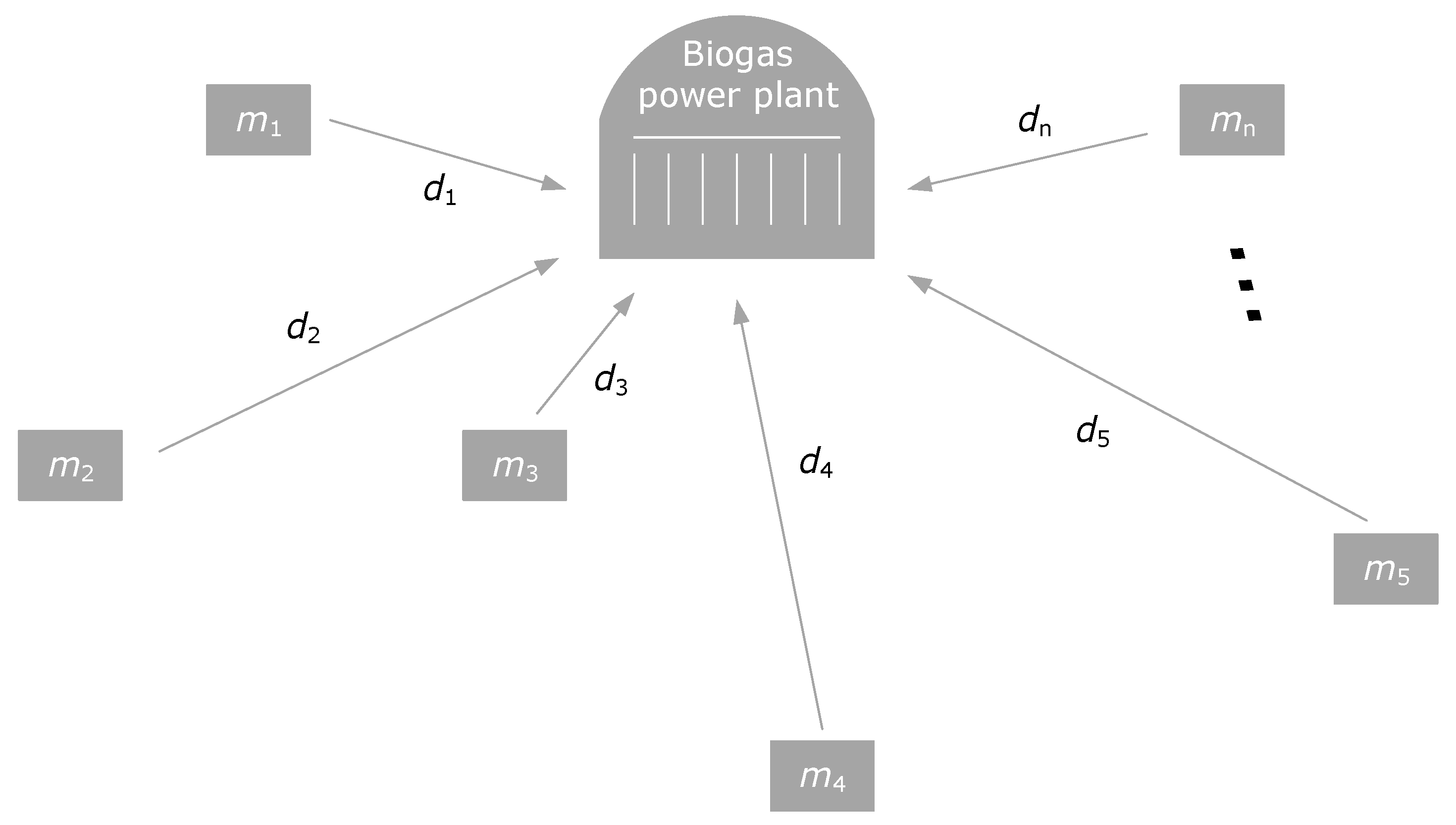
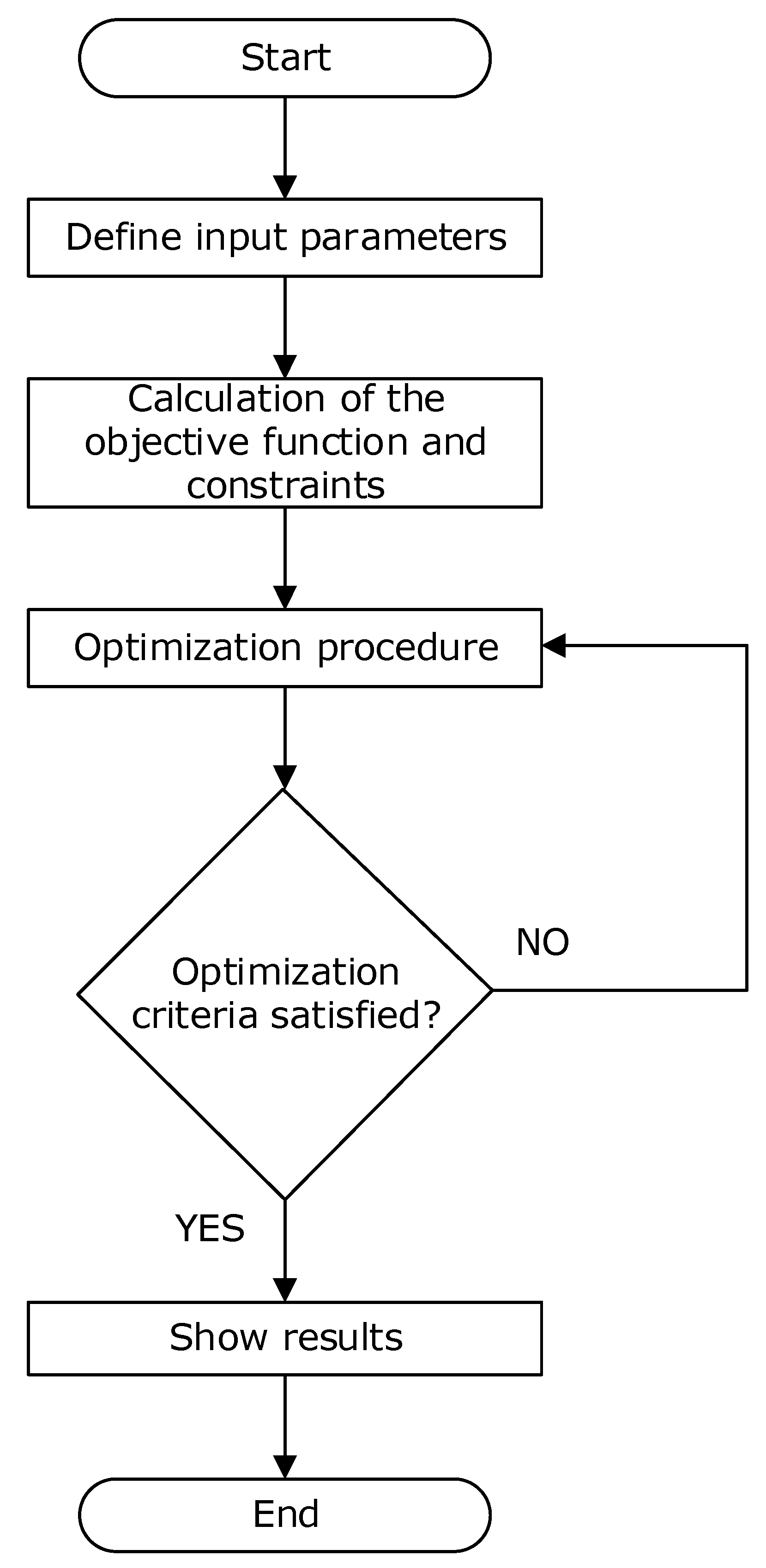
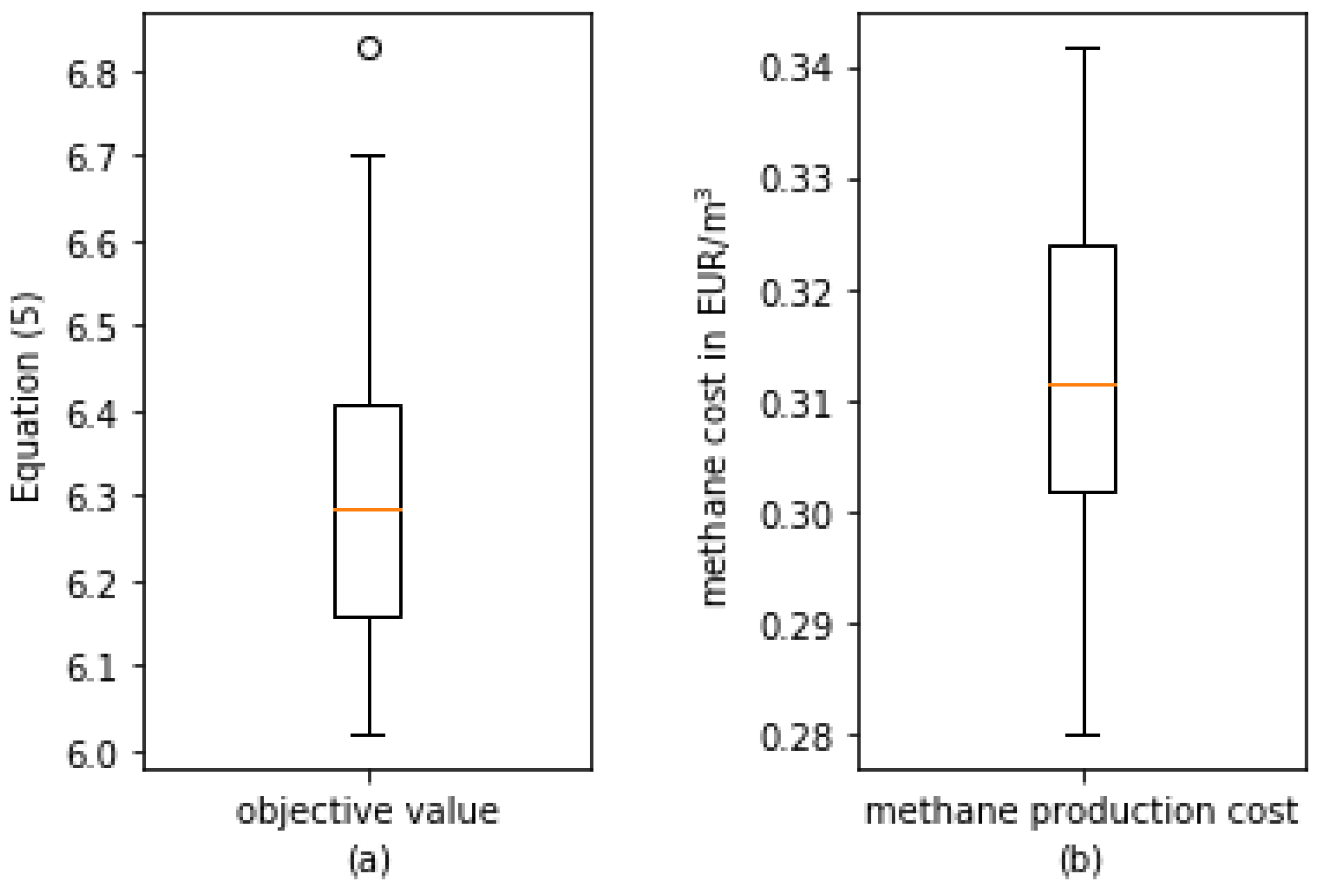
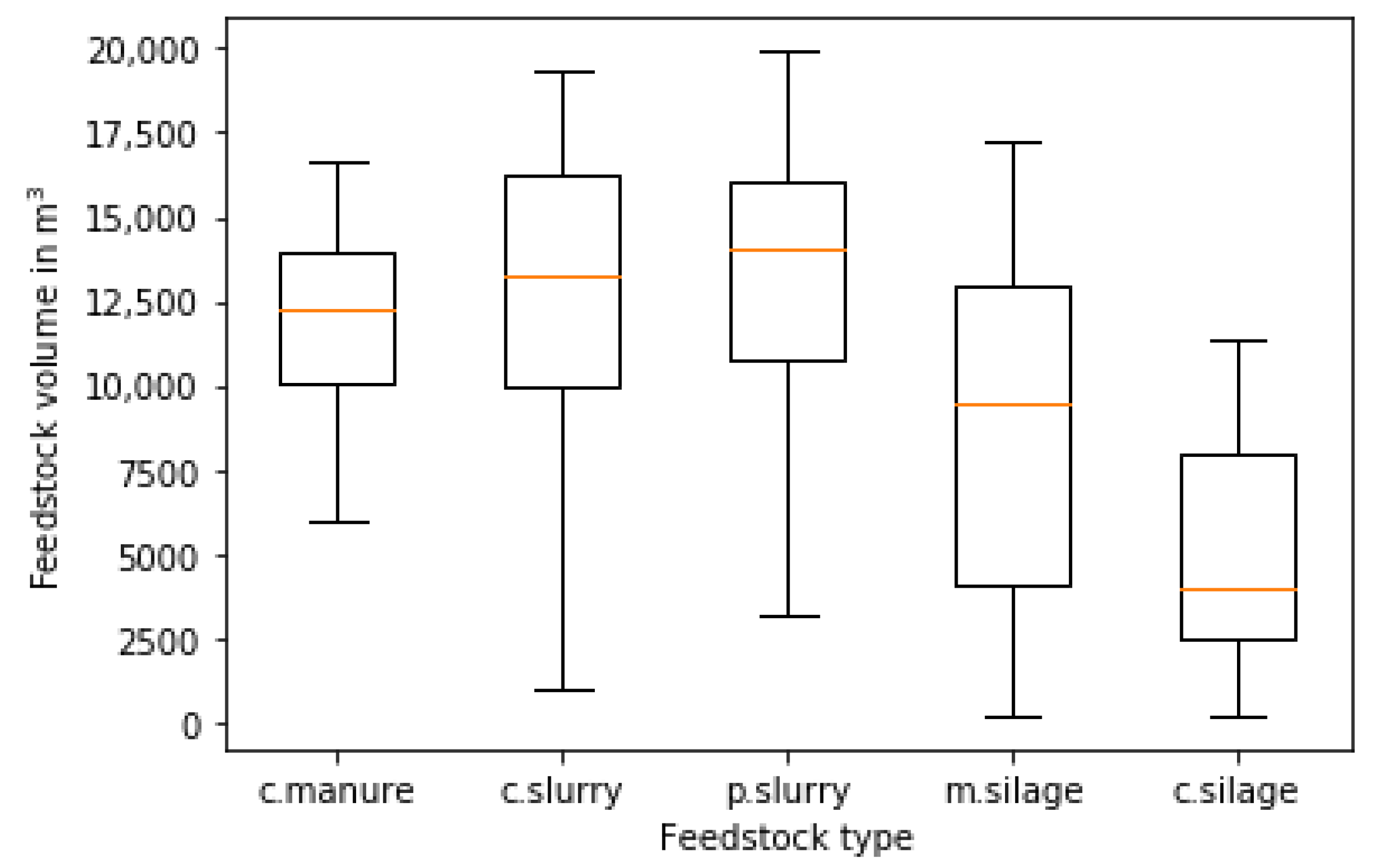
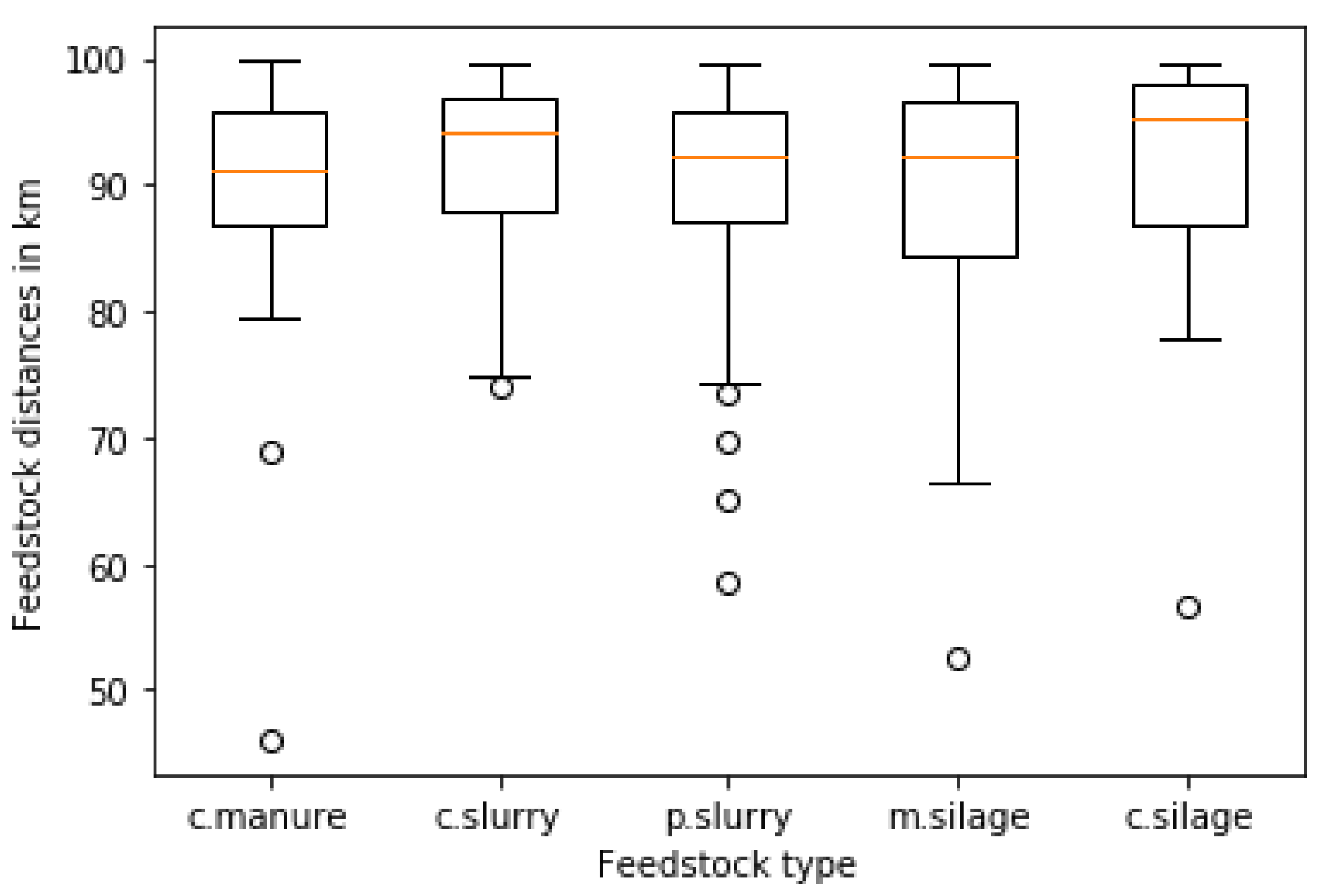
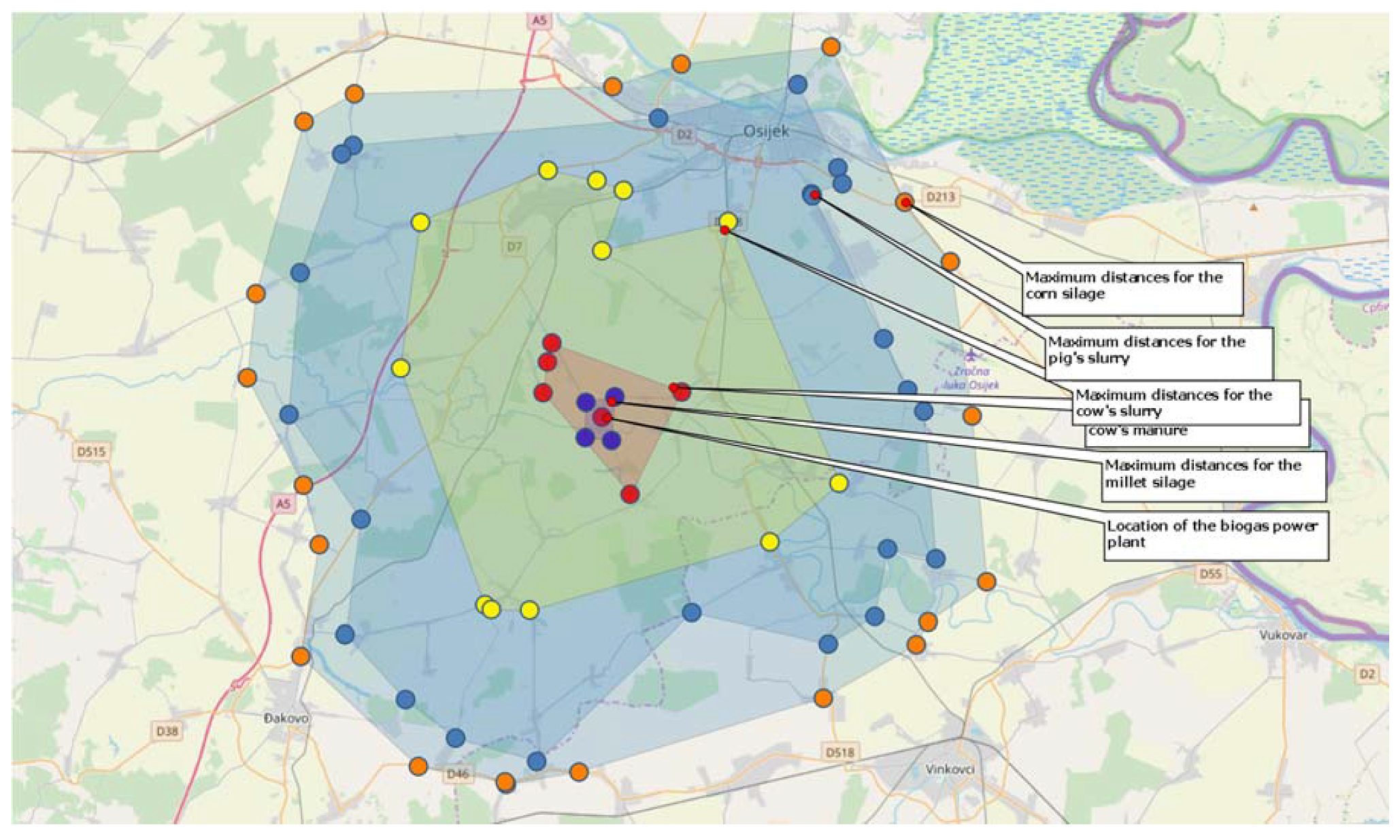
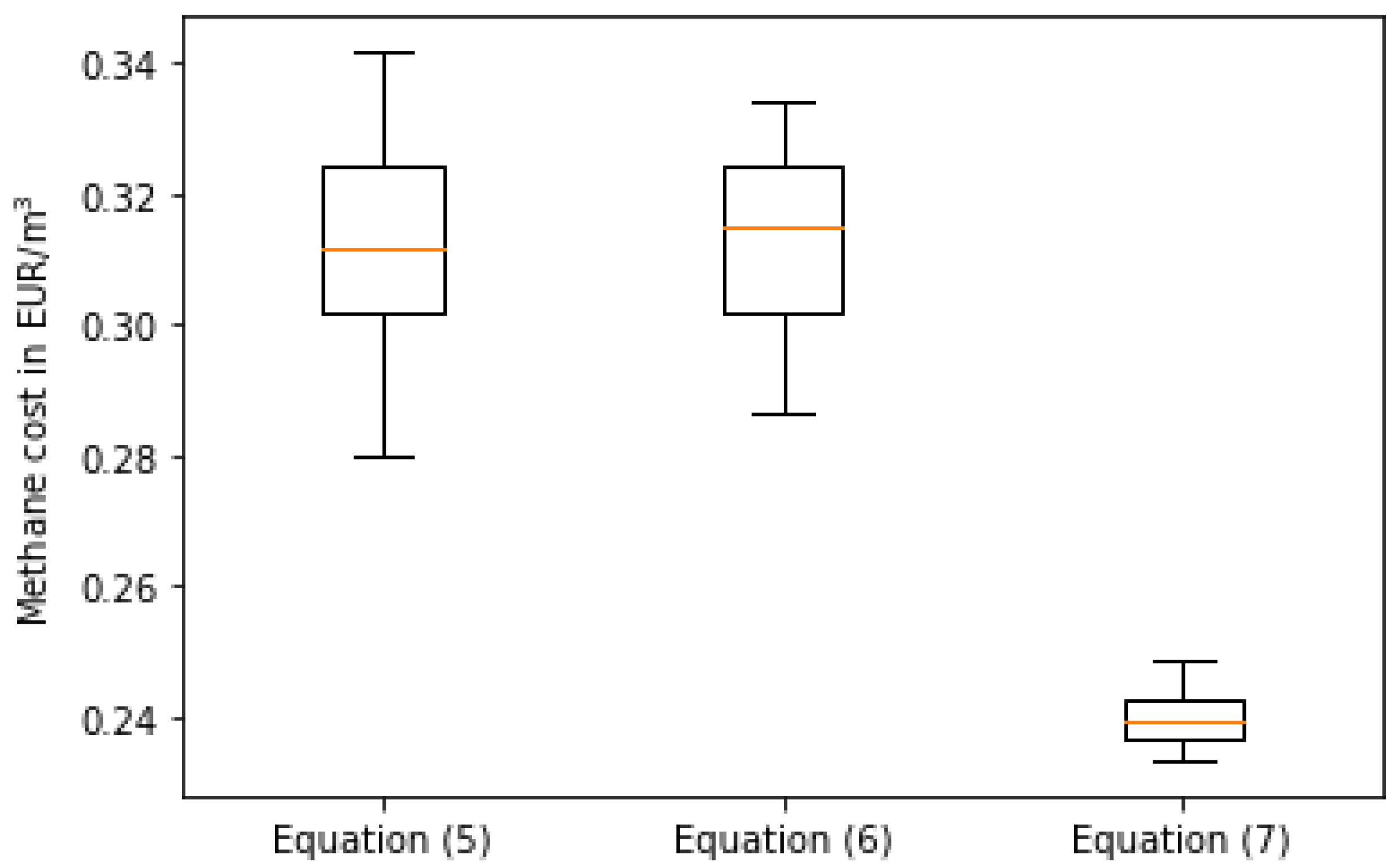
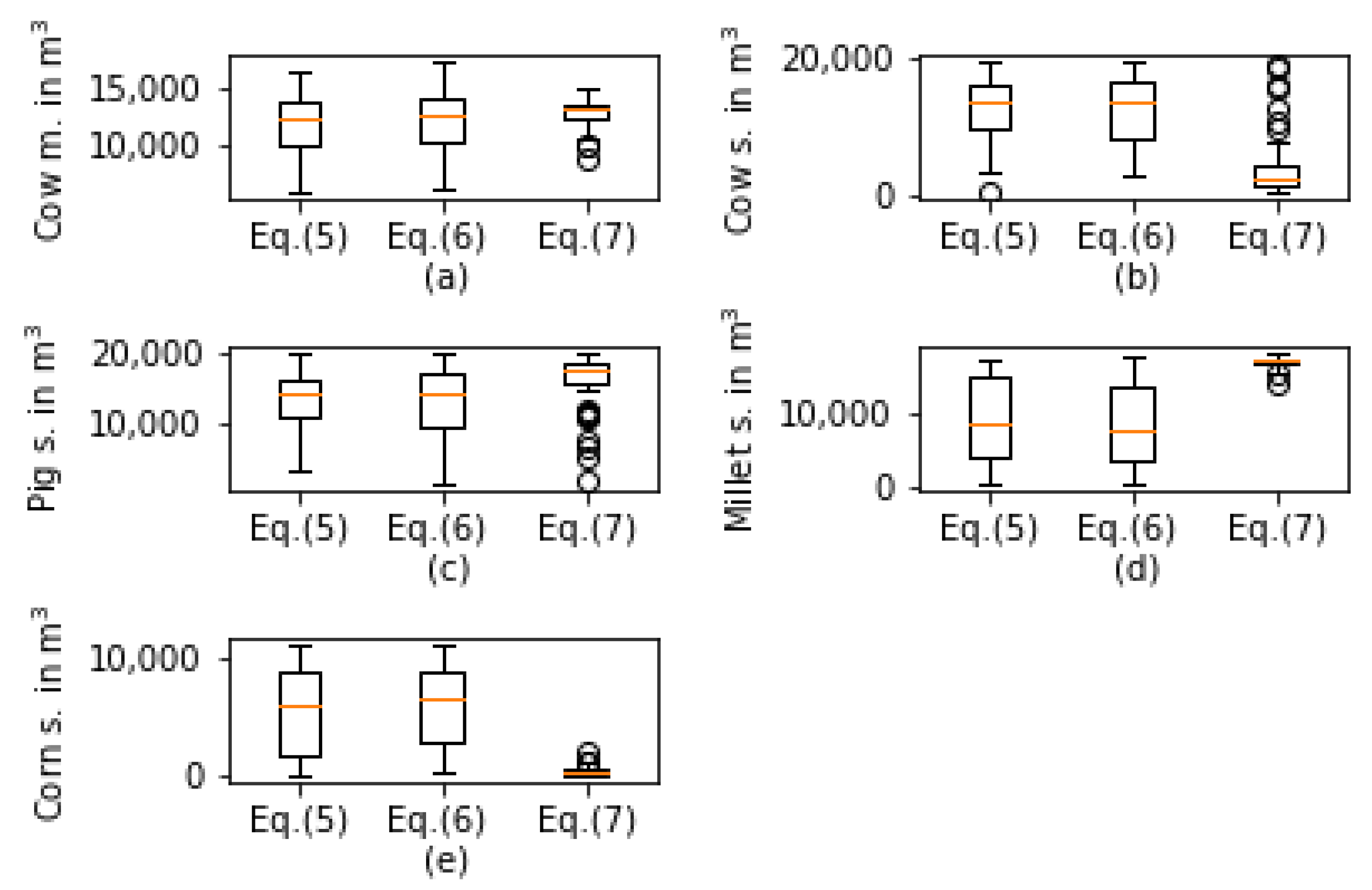
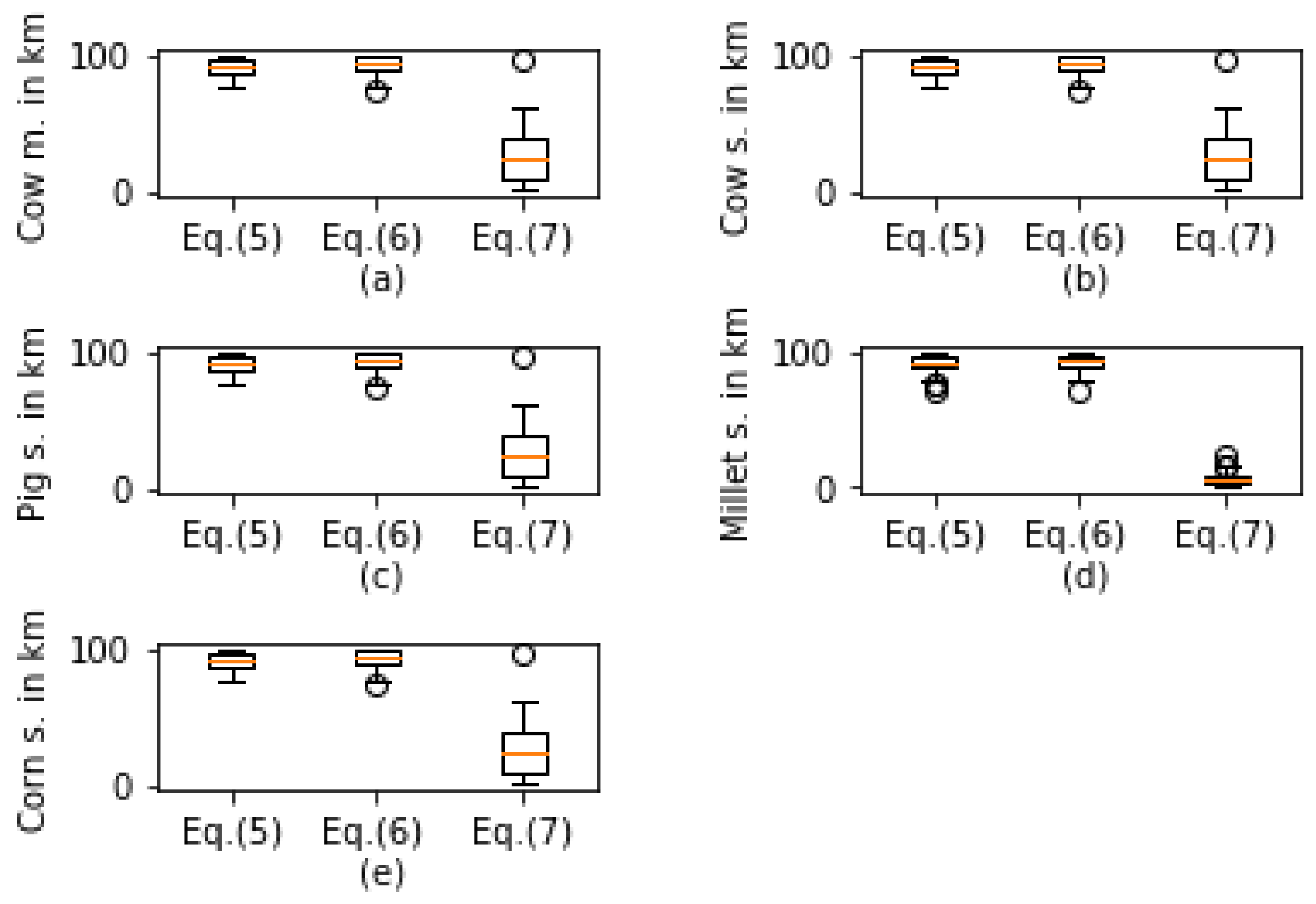
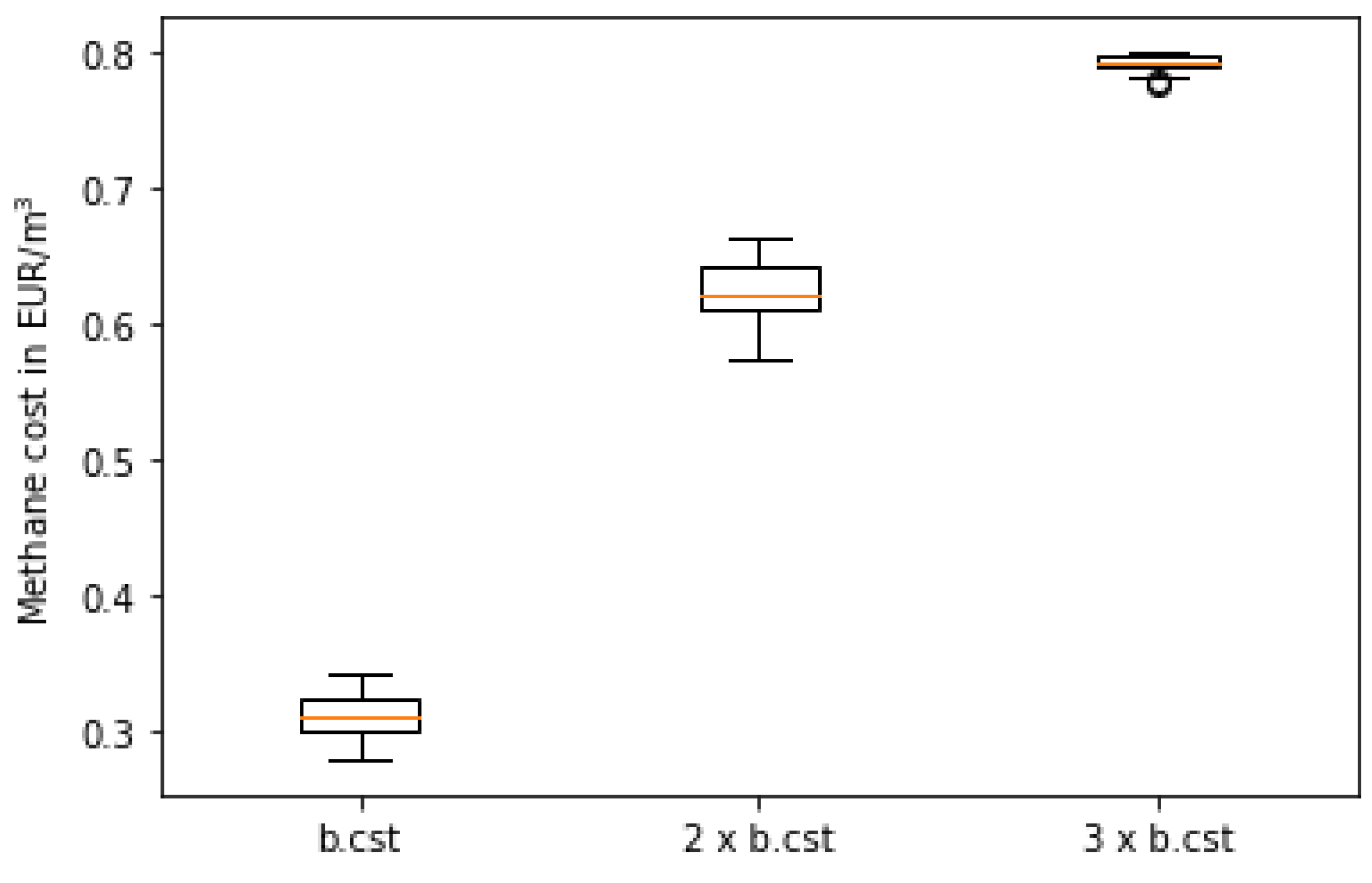
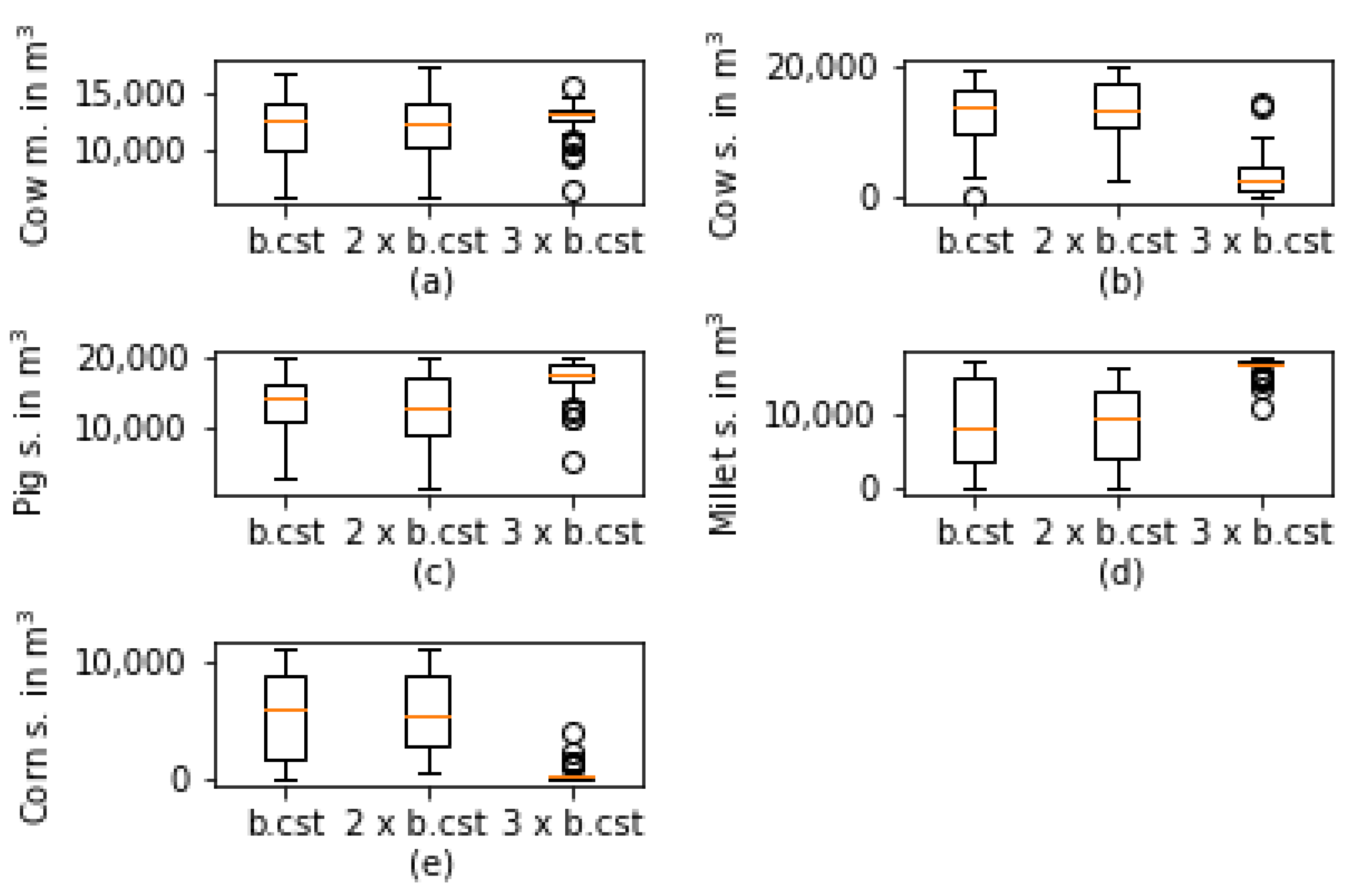
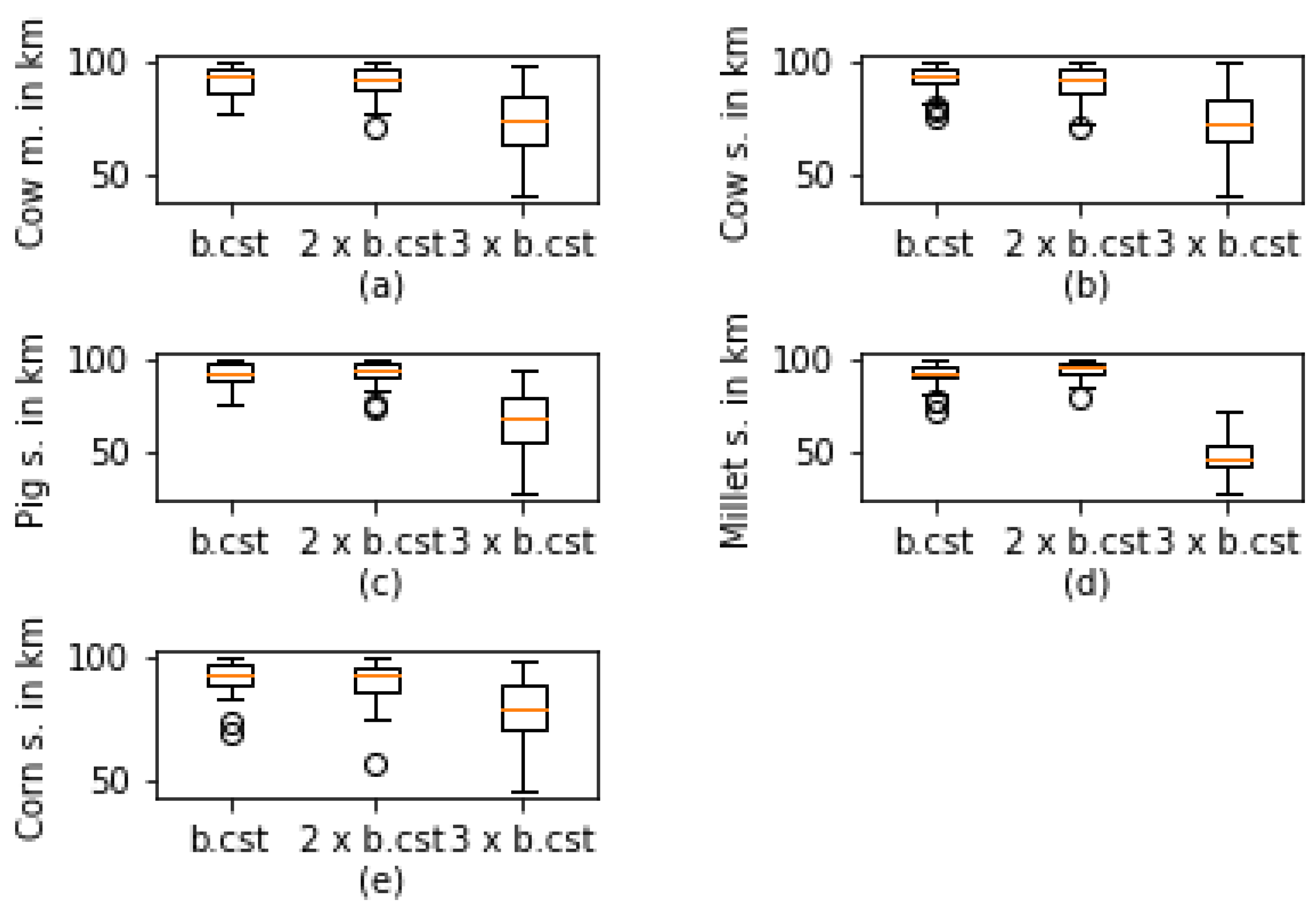
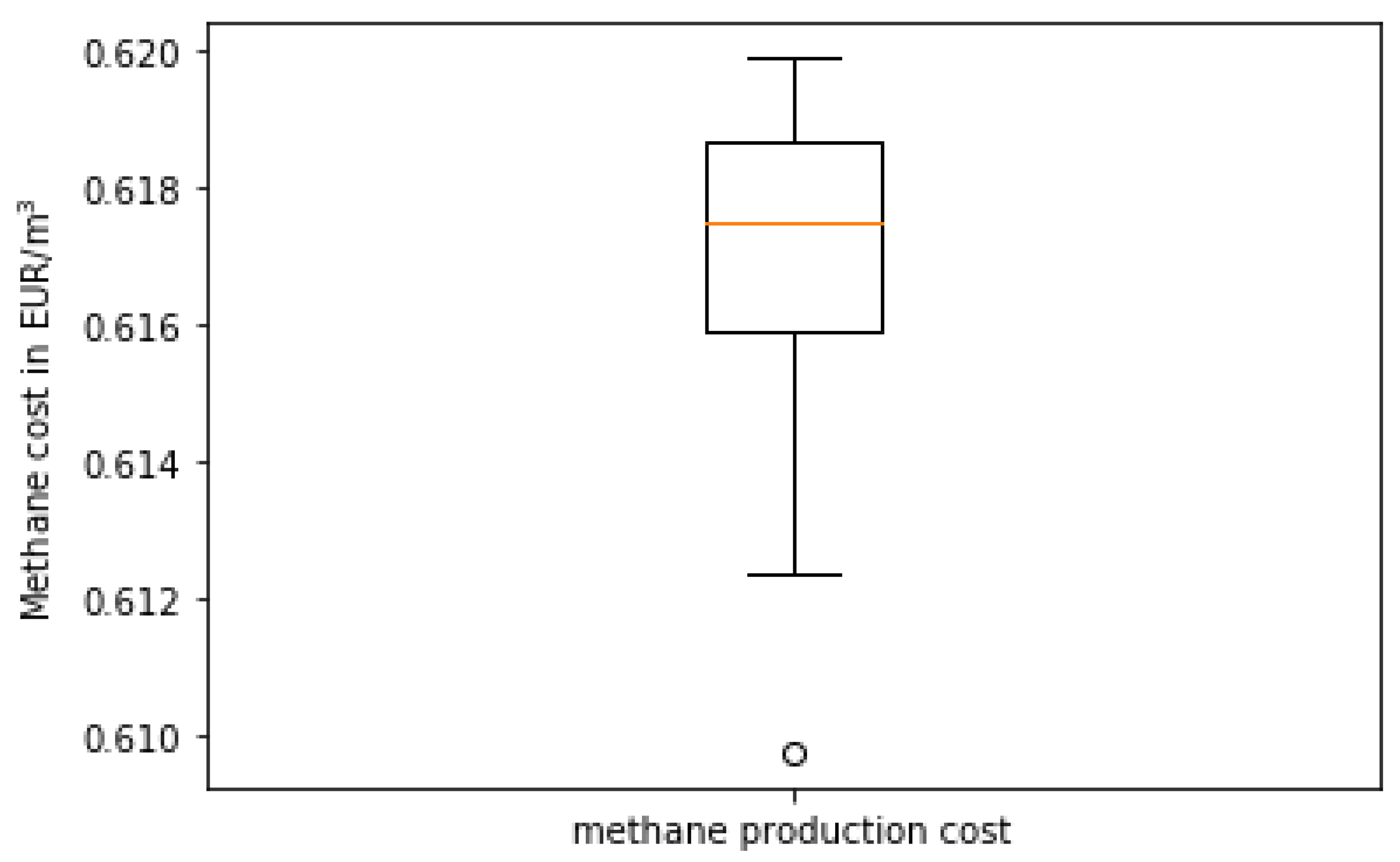
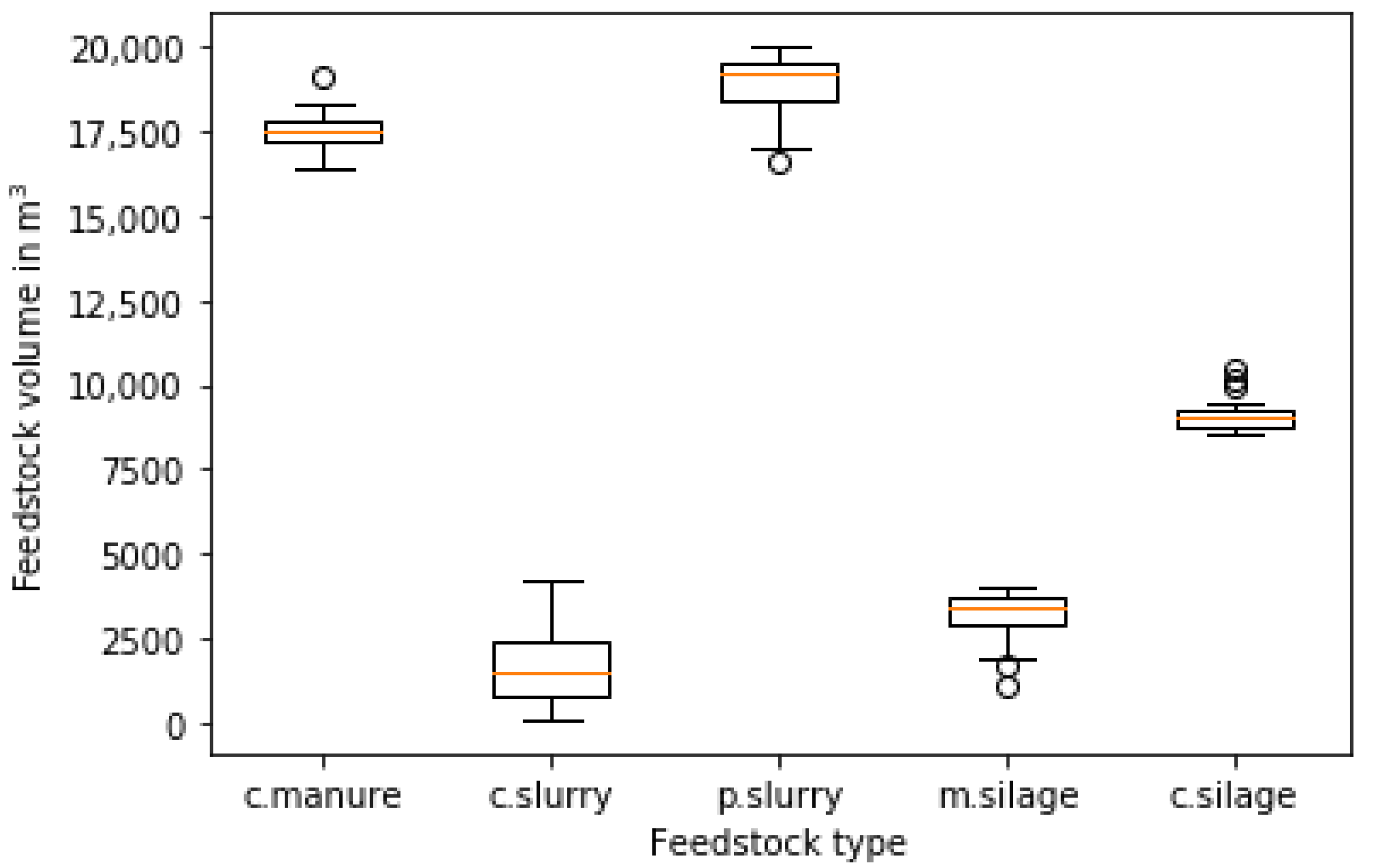
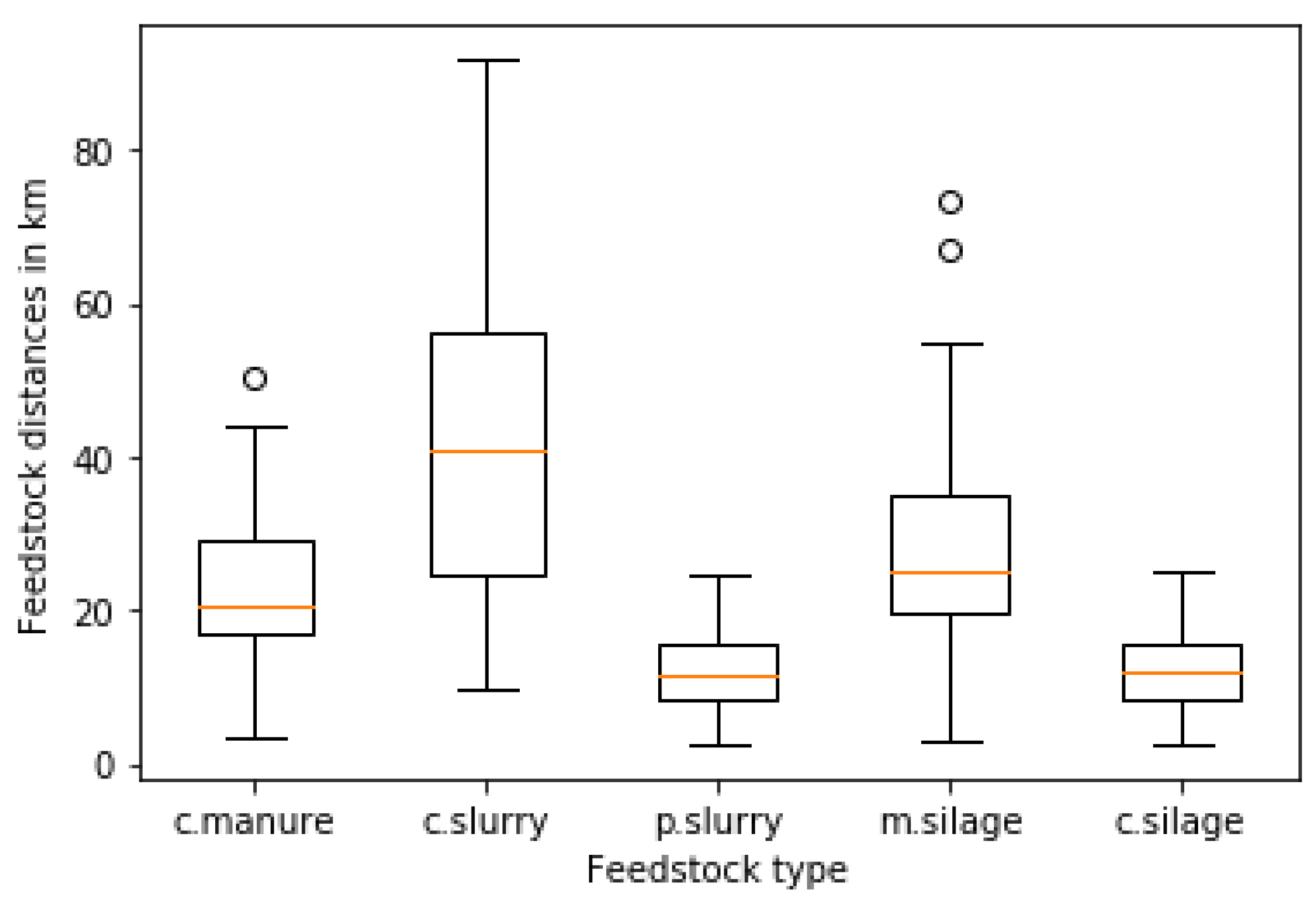
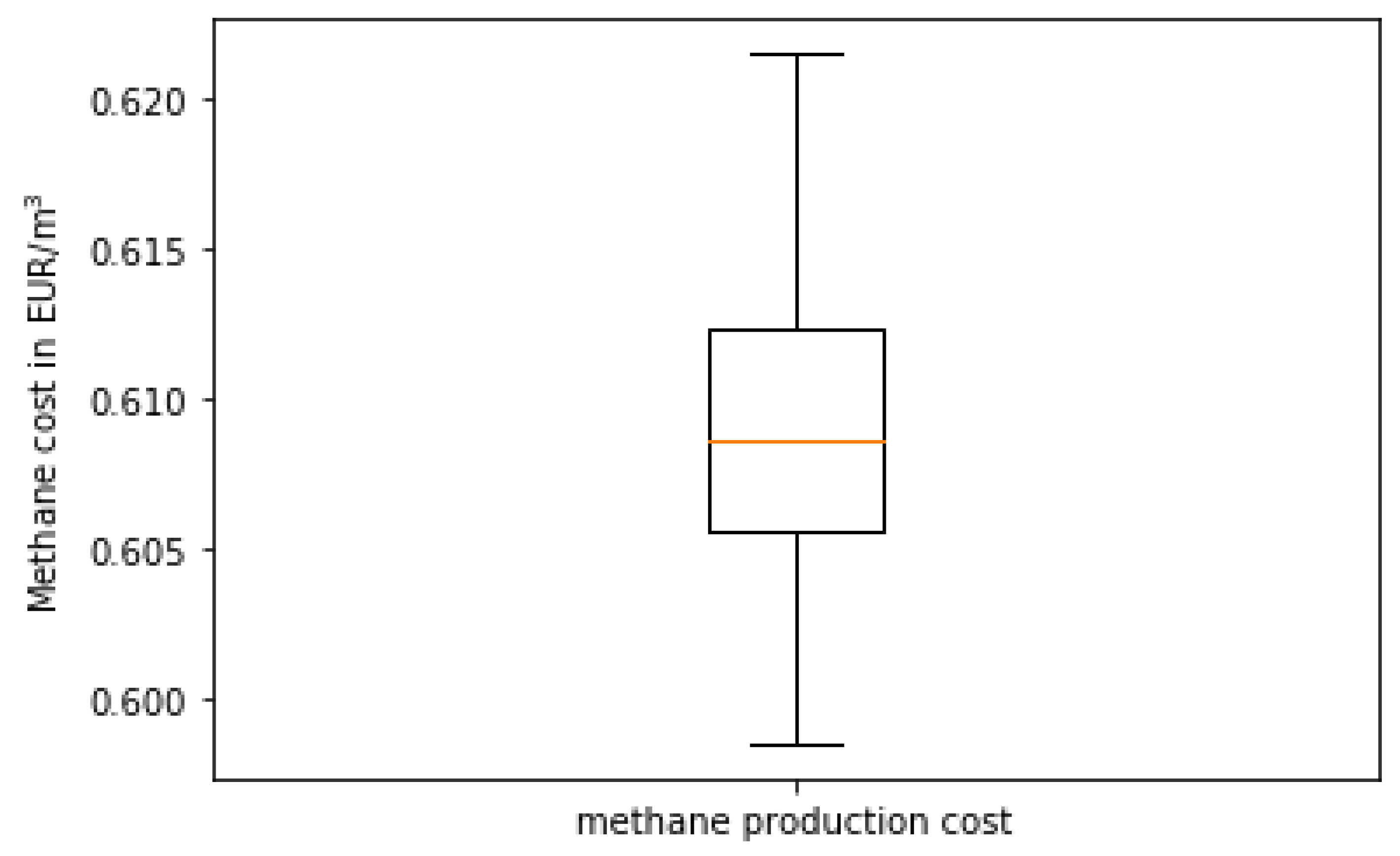
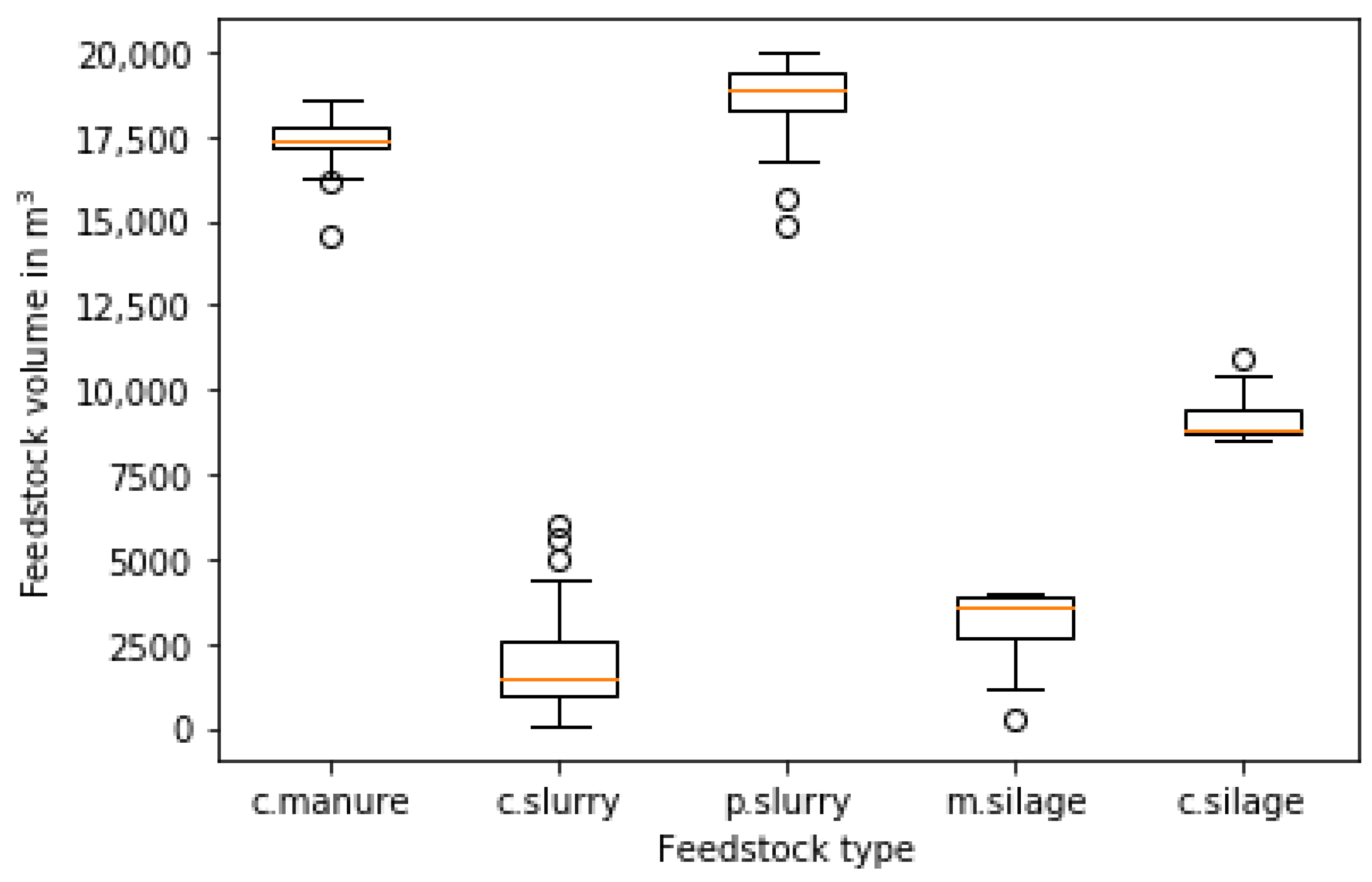
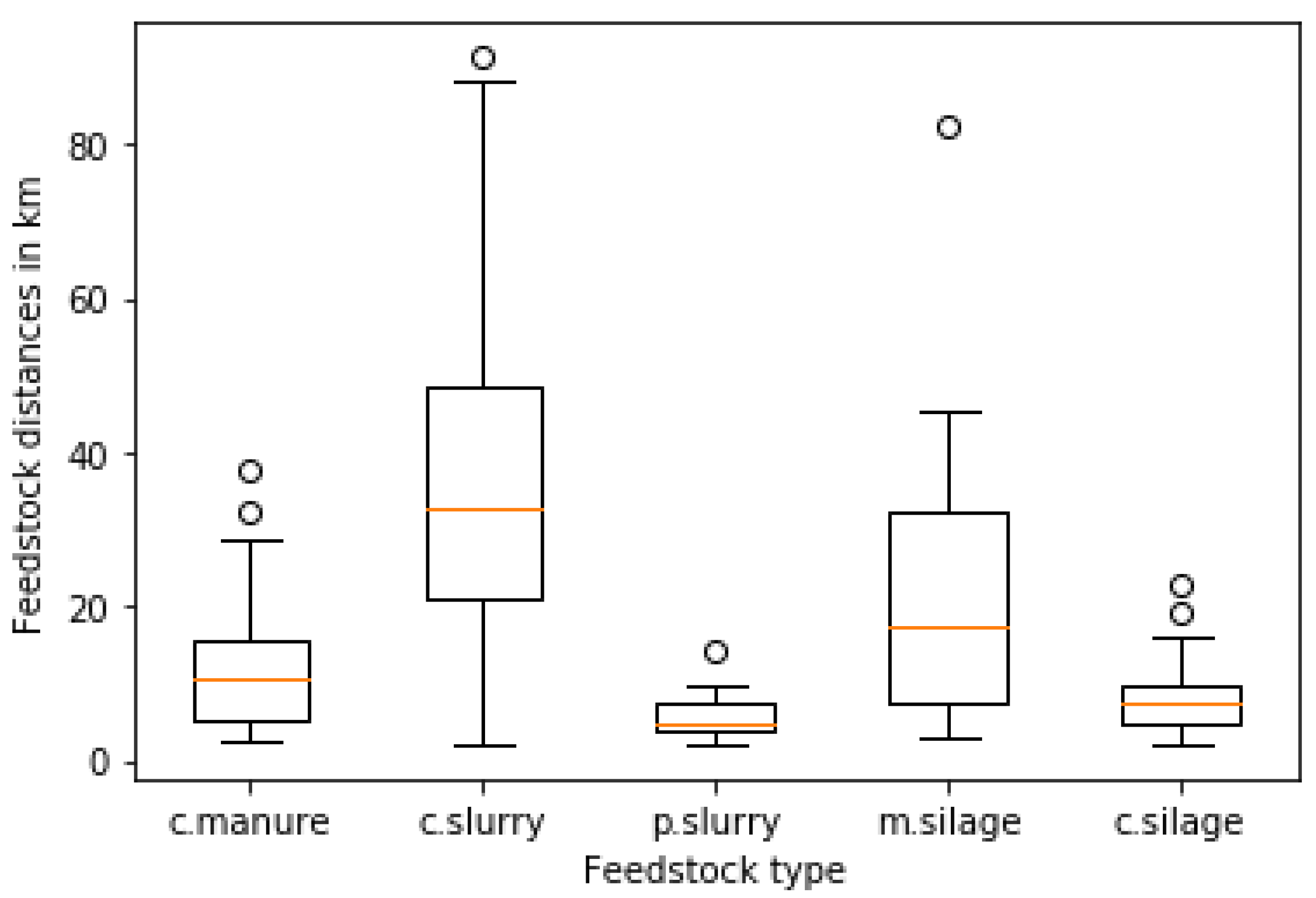
| Constraint | Expression | Lower Value | Upper Value |
|---|---|---|---|
| HRT1s | (12) | 50 days | 60 days |
| ymax | (14) | - | 20% |
| Mi,max | (17) | - | 20,000 tons |
| di,max | (18) | - | 100 km |
| Vmethane, req | (22) | 2,212,121 m3 | 2,212,121 m3 |
| cmethane, max | (23) | - | 0.21–0.75 EUR/m3 [58] |
| rmin | (24) | 0.1 | - |
| rmax | (24) | - | 0.5 |
| Type of the Feedstock | Dry Matter (%)—A | Organic Matter (% of Dry Matter)—B | Specific Biogas Yield from Organic Matter (m3/t)—C | Biogas Yield of the Feedstock (m3/t of Input)—A/100 x B/100 x C | |
|---|---|---|---|---|---|
| cow’s manure | 25.0 | 78.0 | 260 | 50.07 | |
| cow’s slurry | 8.0 | 78.0 | 450 | 28.08 | |
| pig’s slurry | 7.0 | 80.0 | 550 | 30.08 | |
| millet silage | 29.4 | 93.0 | 560 | 153.12 | |
| corn silage | 35.0 | 90.0 | 650 | 204.75 |
| Type of the Feedstock | Biogas Yield of the Feedstock (m3/t of Input)—vi | Share of Methane in Biogas—xi | Specific Density (t/m3)—ρi | Cost of the Feedstock (EUR/t)—ci | Cost of the Feedstock Transport (EUR/m3)—cti |
|---|---|---|---|---|---|
| cow’s manure | 50.07 | 60.0% | 0.6 | 3.00 | 0.0094·d 1 + 2.4 |
| cow’s slurry | 28.08 | 60.0% | 1.0 | 2.00 | 0.0214·d + 3.0 |
| pig’s slurry | 30.08 | 65.0% | 1.0 | 1.20 | 0.0187·d + 2.8 |
| millet silage | 153.12 | 54.0% | 0.7 | 17.00 | 0.04·d + 3.5 |
| corn silage | 204.75 | 55.0% | 0.75 | 34.00 | 0.04·d + 3.5 |
| Type of the Feedstock | Amounts (t/a) | Maximum Distance (km) | Objective Function Value | Cost of Methane (EUR/m3) | Possible Solutions |
|---|---|---|---|---|---|
| cow’s manure | 9737 | 89.5 | 6.49 | 0.311 | Solution 1 |
| cow’s slurry | 11,727 | 96.2 | |||
| pig’s slurry | 18,143 | 96.0 | |||
| millet silage | 8827 | 68.9 | |||
| corn silage | 5653 | 97.5 | |||
| cow’s manure | 15,407 | 82.3 | 6.47 | 0.291 | Solution 2 |
| cow’s slurry | 3945 | 95.5 | |||
| pig’s slurry | 15,349 | 88.1 | |||
| millet silage | 11,153 | 85.0 | |||
| corn silage | 4099 | 88.5 |
| Type of the Feedstock | Amounts (t/a) | Maximum Distance (km) | Objective Function Value | Cost of Methane (EUR/m3) | Possible Solutions |
|---|---|---|---|---|---|
| cow’s manure | 15,282 | 98.0 | 5.27 | 0.300 | Solution 1 |
| cow’s slurry | 8223 | 88.3 | |||
| pig’s slurry | 11,561 | 95.0 | |||
| millet silage | 10,892 | 97.0 | |||
| corn silage | 4317 | 98.0 | |||
| cow’s manure | 7124 | 91.3 | 5.26 | 0.304 | Solution 2 |
| cow’s slurry | 13,525 | 88.7 | |||
| pig’s slurry | 16,890 | 99.5 | |||
| millet silage | 15,684 | 95.3 | |||
| corn silage | 1272 | 99.5 |
| Type of the Feedstock | Amounts (t/a) | Maximum Distance (km) | Objective Function Value = Cost of Methane (EUR/m3) | Possible Solutions |
|---|---|---|---|---|
| cow’s manure | 12,137 | 4.7 | 0.235 | Solution 1 |
| cow’s slurry | 2500 | 14.9 | ||
| pig’s slurry | 19,186 | 21.5 | ||
| millet silage | 17,245 | 1.4 | ||
| corn silage | 20 | 24.0 | ||
| cow’s manure | 13,266 | 41.0 | 0.235 | Solution 2 |
| cow’s slurry | 1397 | 45.5 | ||
| pig’s slurry | 17,722 | 0.7 | ||
| millet silage | 17,299 | 6.6 | ||
| corn silage | 117 | 37.8 |
© 2020 by the authors. Licensee MDPI, Basel, Switzerland. This article is an open access article distributed under the terms and conditions of the Creative Commons Attribution (CC BY) license (http://creativecommons.org/licenses/by/4.0/).
Share and Cite
Topić, D.; Barukčić, M.; Mandžukić, D.; Mezei, C. Optimization Model for Biogas Power Plant Feedstock Mixture Considering Feedstock and Transportation Costs Using a Differential Evolution Algorithm. Energies 2020, 13, 1610. https://doi.org/10.3390/en13071610
Topić D, Barukčić M, Mandžukić D, Mezei C. Optimization Model for Biogas Power Plant Feedstock Mixture Considering Feedstock and Transportation Costs Using a Differential Evolution Algorithm. Energies. 2020; 13(7):1610. https://doi.org/10.3390/en13071610
Chicago/Turabian StyleTopić, Danijel, Marinko Barukčić, Dražen Mandžukić, and Cecilia Mezei. 2020. "Optimization Model for Biogas Power Plant Feedstock Mixture Considering Feedstock and Transportation Costs Using a Differential Evolution Algorithm" Energies 13, no. 7: 1610. https://doi.org/10.3390/en13071610
APA StyleTopić, D., Barukčić, M., Mandžukić, D., & Mezei, C. (2020). Optimization Model for Biogas Power Plant Feedstock Mixture Considering Feedstock and Transportation Costs Using a Differential Evolution Algorithm. Energies, 13(7), 1610. https://doi.org/10.3390/en13071610








